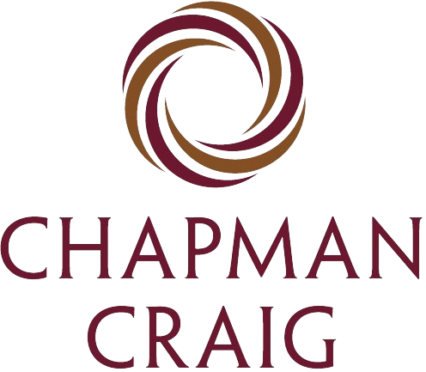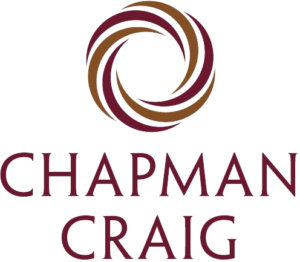What can ChapmanCraig do for me?
We work closely with our clients to assess financial objectives, risk tolerance and circumstances that define your current financial situation. Investment strategies are dependent upon our clients’ financial situation and objectives, with a focus on long-term capital appreciation and wealth preservation as well as any current or anticipated income needs.
The investment portfolios we manage provide the stability, income and broad international diversification necessary for you to reach your financial goals.
What is your investment approach?
Our investment portfolios are broadly diversified across asset classes and geographies, incorporating fixed income and equity investments typically in over 60 financially sound companies, most of which having a global reach and a solid international business footprint. Some fixed income instruments are issued by governments and their agencies.
Every purchase for a client’s portfolio is made with the intention of holding such security for a sufficient amount of time to allow for the significant increase in shareholder value that we expect to occur. We believe that these carefully constructed portfolios will provide our clients with the defensive strength they need during periods of market consolidation and the robust performance they want during strong markets.
How does ChapmanCraig differentiate itself from other Investment Advisors?
When it comes to wealth management, having the right partner is essential. A big international company can give you the investment resources you need. On the other hand, a small local boutique can give you that personal touch. Since 1995, employee-owned ChapmanCraig has offered its special brand of global investing with a local personality to help grow and protect the wealth of high net worth individuals and families.
In what way does ChapmanCraig work with other service providers?
We have entrusted Letko, Brosseau & Associates Inc. (LBA), RBC Investor Services and ScotiaTrust to help us provide the solid global investment performances, security and transparent operations in which our clients can put their trust.
Letko, Brosseau & Associates (Portfolio Manager)
With over US$25 billion in assets under management, Montreal-based LBA has helped drive ChapmanCraig’s consistent and outstanding performance, having beaten their benchmarks for over 20 years. LBA is registered with the provincial securities commissions in Canada and the U.S. Securities and Exchange Commission; and complies, with respect to U.S. clients only, with the Advisers Act of 1940
RBC Treasury and Investor Services and Scotiabank (Custody Banks)
Both the Royal Bank of Canada and ScotiaTrust are Schedule 1 commercial banks licensed and regulated by Canadian Banking supervisors and both have over US$250 billion of assets. As custodians for ChapmanCraig’s client funds and securities, these banks give our operations the transparency and security needed to ensure a trusting relationship with our clients
We work with and can recommend professionals to assist with respect to wills, insurance needs, trusts, tax planning and retirement planning in Hong Kong as well as regionally. We do not take referral fees from any service provider.
Is ChapmanCraig supervised by a financial regulator?
ChapmanCraig is supervised and licensed by the Securities and Futures Commission, Hong Kong financial services regulator. We have been licensed by the SFC since inception in 1996. Our Central Entity Number is ACW278.
We are licensed to provide asset management advice, as well as advice in connection with securities. Each of our senior managers are fully licensed. You may confirm our license by accessing the SFC’s web site at http://www.sfc.hk/web/EN/regulatory-functions/intermediaries/licensing/register-of-licensees-and-registered-institutions.html
How does ChapmanCraig protect the assets in my account?
ChapmanCraig maximizes the protection of your assets by doing the following:
- Third party custodian: Your assets are held in an account at a third-party custodian. We use two world class banks, supervised by Canada’s banking regulators – Royal Bank of Canada and ScotiaTrust. Each of which have assets over $250 billion and very large custodian operations. ChapmanCraig has only the right to issue trading instructions with respect to your account. It cannot access your cash other than to receive its advisory fees. You are the only one who can deposit to or withdraw from your account.
- Independent Monthly Statement Trails: You receive account statements from your custody bank directly from that bank, as well as statements from us. This assures you that there are no systematic defects in the statements that you are receiving from your discretionary advisor.
- No rehypothecation: ChapmanCraig clients only have cash accounts at the custody bank. That means at no time can the cash or securities held in your account be loaned out or borrowed by ChapmanCraig, LBA or another financial services firm.
- No proprietary trading: Neither we nor Letko Brosseau & Associates, that provide the portfolio management function for our accounts, undertake any proprietary trading. However, the principals of each firm maintain financial accounts on the same basis as do our clients.
Can ChapmanCraig assist me with financial / retirement planning?
For many clients we prepare and regularly update relevant financial information which includes forecast statements of personal cash flows and net assets. These are particularly valuable for those nearing retirement, or that have received lump sum payments, such as a divorce settlement, a retirement payment or from the disposition of a business or major asset. These can assist clients with estate planning and asset allocation decisions, particularly as they may need to fund a portion of future living expenses from their investment accounts.
Accounts
What types of accounts does ChapmanCraig currently support?
ChapmanCraig provides segregated accounts managed on a discretionary basis. In some cases, we provide access to LBA global funds, where the account size does not meet requirements for a segregated account.
Who may open an account on ChapmanCraig?
Any individual (18 or over) or entity such as a corporation, trust or partnership may open an account with us. Accounts may be open for individuals under 18 years of age by appropriate guardians. We can also open accounts with Americans who are resident in Asia.
Do you have a minimum fee or minimum account size?
In order to open a segregated discretionary account, you would need to invest or have available for investment in a short period of time, US$2.5 million. We can open accounts for US$1 million and above, but those accounts may not be managed on a segregated basis.
We do not have minimum fees, although the custody banks impose a minimum fee that do not generally impact our clients given account sizes.
Can I open multiple accounts?
Depending upon the circumstances, you can open multiple accounts, and the total amount across those accounts will be used to calculate the minimum investment required. Please contact ChapmanCraig to discuss the circumstances in which this could be arranged.
Where is my money held?
Your assets are held with one of two large custody banks in Canada, Royal Bank of Canada, or Scotiabank. The custody bank will independently forward to you an investment statement each month, setting out the securities held and valuations.
Can I change an individual account into a joint or trust account and vice versa?
Yes and we will assist you with any changes that suit your changing wealth management or family circumstances. We would likely required additional documentation, but the process is quick and painless.
Fees
How does ChapmanCraig charge for its services?
ChapmanCraig charges a quarterly advisory fee based on an annual fee rate of 1.25% of assets under management. That fee declines on a percentage basis as the account size increases. We also charge a performance fee but only when total returns in a year have beaten an agreed threshold. The performance fee incorporates a high-water mark mechanism.
Do you charge for meetings or conversations?
We do not have any fees other than our advisory fee charged based on assets under management. We strive to build solid, long-term relationships with our clients and encourage regular conversations with our clients. However, these do not create any additional costs.
Do you lower the fee for larger accounts?
Yes, our fee scale reflects a lower percentage fee against the assets under management as the account size increases.
What kind of trading commissions will I incur with a ChapmanCraig account?
Trades for your account are managed by Letko Brosseau & Associates, a Canadian independent asset management firm that manages over $25 billion. LBA uses multiple trading platforms and manages commission rates to approximately 0.1% on trades.
Are there custodial fees associated with accounts?
Yes, monthly custody fees will be withdrawn from your account. The fees start at approximately 0.2% of assets, but decline for larger accounts.
Are there exit fees due if I choose to close my ChapmanCraig account?
There are no fees in connection with the opening or closing of ChapmanCraig accounts.
How are fees calculated?
Each quarter you are charged an advisory fee equal to 1/4 of the annual rate multiplied by the net market value of your invested assets held at the beginning of that quarter.
The performance fee is calculated as 15% of the amount by which the account’s return was greater than 7%, after advisory fees. In addition, the return is calculated using the higher of the market value at the beginning of the period or the highest amount from prior period-ends (or a high-water mark).
When does ChapmanCraig charge its advisory fee?
The advisory fee is invoiced approximately six weeks into each quarter. The performance fee is only calculated at the end of each year and invoiced in February in those years in which is it payable.
Are there any other advisory fees in connection with a ChapmanCraig account?
No, the management and performance fees paid to ChapmanCraig are the total of advisory fees in connection with the accounts. We pay our sub-manager from our fee.
Funding
How do I fund my account?
You may transfer cash and/or securities into your ChapmanCraig account by one of two methods:
Wire Transfer: You will need to initiate a wire transfer from your bank account to the account that we will assist you to set up with your custody bank. In most cases, the funds will be deposited in your account the next business day after the wire transfer is received by the custody bank. Your funds will be invested immediately thereafter.
Account Transfer: You can transfer from an existing brokerage account held at another firm. You may need to liquidate or exclude certain funds and alternative investments. We will assist you with this process.
The cash and securities can originate from any recognized financial institution based in a country that is an FATF (Financial Action Task Force) member.
When can I expect my money to be invested?
Wire transfer amounts are generally available for investment the day following receipt.
How do I deposit additional funds into my account?
You would follow the same process as the initial funding by first advising us that you intend to make an additional contribution and then instructing your bank to make the wire transfer. When the funds arrive, we will send you an email confirming receipt.
May I transfer funds from an account under a different name?
Yes, but this needs to be coordinated. We will have advised the custody bank to expect the wire transfer.
Can I transfer my outside portfolio into ChapmanCraig?
Yes. We will assist you with the requirements of your existing brokerage firm and coordinate with the custody bank on your behalf. For transfers from overseas to the custody bank in Canada, this can sometimes take a few weeks.
Can I transfer a portion of an existing brokerage account to ChapmanCraig?
Yes, you can transfer a part of an existing account transfer, and we will assist you with this, particularly with respect to instructions to your existing brokerage and following up with the your custody bank.
Withdrawals
How do I make a partial withdrawal from my account?
If you wish to withdraw a part of the funds from your account, you would contact us and we would assist you in preparing a written instruction for the custody bank and the portfolio manager. This instruction is emailed to the appropriate client relationship manager and will usually be followed by a telephone call to ensure that you have made those instructions.
How do I withdraw all the funds in my account?
To withdraw all the funds in your account, you will need to prepare and sign an account closing instruction that also sets out the bank account details where you would like the proceeds sent. The form will be forwarded to the custody bank, your securities liquidated and proceeds sent upon settlement.
You may also ask that securities be sent to another financial services firm, although this will take more time and we will assist you with those instructions.
How long does it take to withdraw my funds?
The time it takes to complete a partial withdrawal depends on several factors including how many securities need to be liquidated to accommodate the withdrawal, but most withdrawals take 4 or 5 business days before the requested funds are back in your bank account.
This process may take as few as two business days, depending upon the amount of securities that may need to be liquidated.
If you are closing the account the process should not take much longer but it may because of the additional securities liquidations required, the possibility of holidays in some foreign markets.
How much can I withdraw?
We do not have any limits on the amount that you can withdrawal; however, we do have account size minimums. In addition, because your portfolio is a balanced portfolio, we discourage frequent withdrawals and contributions as this would require rebalancing and incur additional costs.
Does ChapmanCraig charge fees to withdraw funds?
ChapmanCraig does not charge fees when you withdraw funds or close your account. Neither does the custody bank.
How does ChapmanCraig choose which investments to sell when I withdraw?
To satisfy a withdrawal request, securities will be sold in such a way as to maintain your portfolio within your target allocation.
However, the sale may change the relative allocations because the securities will not all be sold in the same proportion.
General Questions
How should I decide how much of my investible funds to invest with ChapmanCraig?
Prior to opening an investment account and then on a regular on-going basis, we will have detailed conversations with you to explore your financial situation, investment experience, risk tolerance, investment objectives, family and business circumstances, asset protections in place, and other issues that impact a comprehensive wealth management plan.
Based on your particular circumstances, we will make recommendations and work with you and your family to develop an asset allocation plan or objectives, and this will assist you in deciding the amount that you would contribute or maintain in a ChapmanCraig account.
What would happen to my account if ChapmanCraig were to be acquired or cease doing business?
If ChapmanCraig is acquired your account would remain in your own name and you would be free to add or withdraw money at any time.
In the unlikely event ChapmanCraig were to cease doing business, your account would be held by your custody bank until you transferred your account to a new firm or chose to liquidate your account to receive a wire transfer. During this period, your account would not be managed by LBA.
How do you calculate the investment return contained in client communications?
We use a time-weighted return after fees to calculate account returns. We believe that this is the most appropriate measure as its objective is to neutralize the impact of the timing of cash contributions and withdrawals from the investment account, which we do not control.
Time-Weighted Return (TWR)
TWR compounds the daily returns of your account from the time it was initially funded until present. It is the best way to evaluate the performance of an investment manager because it does not consider when a client deposits or withdraws cash from his/her account. TWR is also the method used by index funds to measure performance. For these reasons we have chosen to display Time-weighted returns on your dashboard. It is a true reflection of how we have managed your money, not a reflection of how your contributions and withdrawals affected your performance.
Can I use ChapmanCraig to time the market?
ChapmanCraig does not believe that market timing is an effective long-term investment approach and does not accommodate or attempt to perform market timing. We recommend clients think about their wealth management and protection as a long term process and not to become fixated on short term fluctuations of the market. ChapmanCraig objective is to support clients with an appropriately constructed, diversified, low-cost but actively managed portfolio.
If you are interested in timing markets, ChapmanCraig is not the right service for you. A traditional brokerage firm that allows you to trade individual securities and guarantees self-directed trade execution is likely better suited to meet your expectations.
Does ChapmanCraig invest my funds all at once or do dollar cost averaging?
We do not believe in market timing, but the portfolio management decisions for your investment account reflect current pricing in the market. Accordingly, new funds into your account are unlikely to be invested all at once, but the reason is not because of dollar cost averaging. The purchase decisions are made over time and it may take one to two months for your account to be fully invested after a fund contribution.
How often do you rebalance my portfolio?
Rebalancing amongst asset classes occurs anytime the classes approach or reach allocation limits. Rebalancing amongst sectors or securities within the account will occur when the analysts and portfolio managers at LBA conclude that a security should be added, sold, or its weighting change. The timing of this is not predictable because it depends on the performance of each of the asset classes, sectors and securities.
Can I, as US resident, receive more information from you or work with you?
No you can’t, we are not registered under the US Investment Advisors Act of 1940.
For more information, get in touch here



